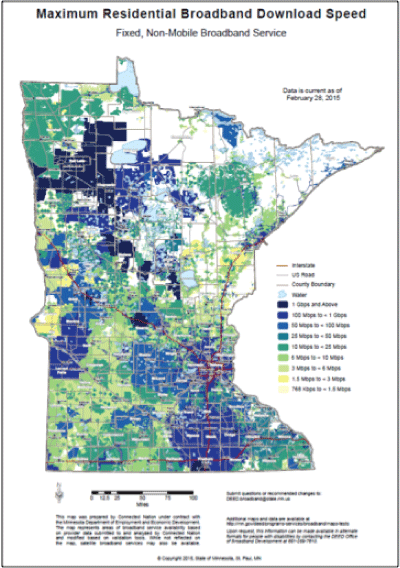by Cameron Macht
May 2016
Five years ago our State Legislature set a goal to place Minnesota in the top five states in the nation for broadband access and speed. To develop policies that would promote the expansion of broadband, the state established the Governor’s Task Force on Broadband, the Governor’s Broadband Subcabinet, and the Office of Broadband Development, which is housed at DEED.
According to the 2015 Annual Report released by the Governor’s Task Force on Broadband in January of 2016, data showed that 91.5 percent of Minnesota households had broadband access at a speed of at least 10 Megabits per second (Mbps) download and 5 Mbps upload. While the report shows that the state has made progress toward reaching its broadband speed goals, it has not yet achieved universal access. Only 80 percent of rural Minnesota households have a broadband connection that meets these speeds.
The Task Force is working to implement “an action plan for identifying and correcting disparities in access and adoption of broadband in all Minnesota communities - urban, rural, and suburban - helping to ensure that homes, schools, hospitals, and businesses have access to the technology and information resources they need to grow and thrive.”
To that end, the Office of Broadband Development has a wide range of information and resources available on DEED’s website to help Minnesota residents understand the broadband options available. The office provides planning resources and tips for communities, opportunities for financial assistance to help pay for broadband services, and information on the Border-to-Border Broadband Development Grant program which included about $10.6 million in funds for unserved and underserved regions across Minnesota in 2016.
The site also includes a wide list of maps and data, including maps of the state’s broadband service inventory, percentage of households served by broadband services, density of broadband providers, broadband growth, and maximum residential upload and download speed. DEED also offers an interactive available broadband service map for Minnesota, where users can type in their location and see a list of available providers.
Technologies and broadband applications have changed quickly over the past five years and will continue to change, which will require higher speeds moving forward. In response the Task Force is encouraging the legislature to update Minnesota’s statutory broadband speed goals in 2016, helping the state seize the opportunity to stay on the leading edge of this transformative technology.
